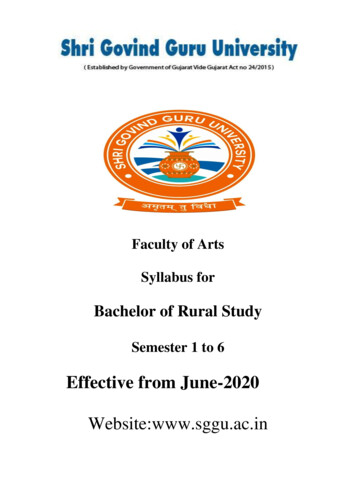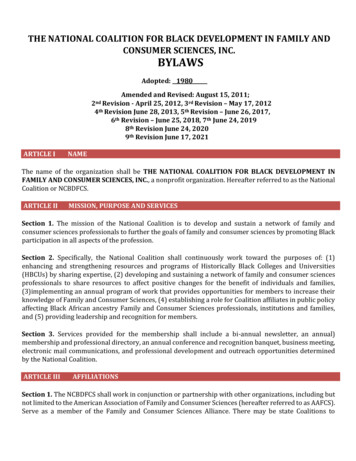
Transcription
Faculty of ArtsSyllabus forBachelor of Rural StudySemester 1 to 6Effective from June-2020Website:www.sggu.ac.in
Course Structure of BRSSr. 204BRS-TypeTotalInternal Practical External Total Credit CreditCORE302050100 2 13CORE302050100 2 13CORE302050100 2 13CORE302050100 2 0033FOUNDATION100100 --FOUNDATION100100 --CORE302050100 2 13CORE302050100 2 13CORE302050100 2 13COREMULTI3030205070100 2 1100333
NARY307010033FOUNDATION100100 --FOUNDATION100100 --CORE302050100 2 13CORE302050100 2 13CORE302050100 2 13CORE302050100 2 0033FOUNDATION100100 --FOUNDATION100100 --CORE302050100 2 13CORECORE303020205050100 2 1100 2 133
MULTIDISCIPLINARY2050100 2 13307010033307010033FOUNDATION100100 --FOUNDATION100100 --CORE302050100 2 13CORE302050100 2 13CORE302050100 2 13CORE302050100 2 13CORECORE -FIELDWORK &REPORT302050100 2 13100100200 3 36MULTIDISCIPLINARY302050100 2 13MULTIDISCIPLINARYCORE303020205050100 2 1100 2 133
RE604BRSCORE605BRSCORE6 606BRSMDC6 601BRSMDC6 602CORE302050100 2 13CORE302050100 2 13CORE302050100 2 13CORECORE RESEARCHWORK &DISSERTATION302050100 2 13100100200 3 36MULTIDISCIPLINARY302050100 2 13MULTIDISCIPLINARY302050100 2 13Total Credits: 126
CORE SUBJECT BRS-CORE303BRS-CORE304EXTSTATUSSUBJECTPAPER TITLECOMPULSORYInsectologyDomestic Animals & CattleBreedsCOMPULSORYIntro. to Horticulture 1COMPULSORYIntro. to Rural Extension 1COMPULSORYIrrigation & Water ShadesCOMPULSORYAnimal ManagementCOMPULSORYPlant Diseases & WeedCOMPULSORYExtension Education 1COMPULSORYAG MAJORADHFREAG MAJORADHFREAG MINORADHFREAG MINORAGRONOMYAH & DAIRYSCI.HOTRI. &FLORI.Crop Production 1Animal Housing ManagementPrinciples of Horticulture 2RURAL EXT.AGRONOMYAH & DAIRYSCI.HOTRI. &FLORI.Intro. to Rural Extension 2Pesticides, Disease & PestControlRURAL EXT.AGRONOMYAH & DAIRYSCI.HOTRI. &FLORI.Extension Education 2RURAL EXT.AGRONOMYIntro. to Rural Extension 2Pesticides, Disease & PestControlCooperative Dairy IndustryIntroduction to Comm.FloricultureCrop Production 1Animal Housing ManagementPrinciples of Horticulture 2
CORE501BRS-CORE-ADHFREAG MAJORADHFREAG MAJORADHFREAG MINORADHFREAG MINORADHFREAG MAJORADHFREAH & DAIRYSCI.HOTRI. &FLORI.Cooperative Dairy IndustryIntroduction to Comm.FloricultureRURAL EXT.AGRONOMYAH & DAIRYSCI.HOTRI. &FLORI.Extension Education 2RURAL EXT.AGRONOMYAH & DAIRYSCI.HOTRI. &FLORI.Community OrganisationRURAL EXT.AGRONOMYAH & DAIRYSCI.HOTRI. &FLORI.Educational PsychologyRURAL EXT.AGRONOMYAH & DAIRYSCI.HOTRI. &FLORI.Animal Breeding & GeneticsRURAL EXT.AGRONOMYAH & DAIRYSCI.HOTRI. &FLORI.RURAL EXT.Educational PsychologyCrop Production 2Animal Health & NutritionFarm Business ManagementSoil SciencesAnimal Breeding & GeneticsGardeningCrop Production 2Animal Health & NutritionFarm Business ManagementSoil SciencesAnimal Breeding & GeneticsGardeningAdv. Tech. in Crop Production 1Dairy FarmingPomology 1Navnirman
-CORE5 506BRS-CORE6 601BRS-CORE601BRS-CORE601BRS-CORE6016 BRS-CORE-AG MAJORADHFREAG MAJORADHFREAG MAJORADHFREAG MAJORADHFREAGRONOMYAH & DAIRYSCI.HOTRI. &FLORI.RURAL EXT.AGRONOMYAH & DAIRYSCI.HOTRI. &FLORI.Communication 1RURAL EXT.AGRONOMYAH & DAIRYSCI.HOTRI. &FLORI.Adaption & DiffusionREAG MAJORRURAL EXT.AGRONOMADPlant Breeding & Genetics 1Social Research Methods 1HFAG MAJORPoultryRURAL EXT.AGRONOMYAH & DAIRYSCI.HOTRI. &FLORI.RURAL EXT.FIELDWORK &REPORTAGRONOMYAH & DAIRYSCI.HOTRI. &FLORI.MAJORSeed Technology 1Mannures& FertilizersIntro. to Veterinary Sci. 1Adv. Tech. in HorticulturePlant Breeding & Genetics 1Animal Rearing 1Olericulture 1Weed ManagementAnimal Physiology 1Forestry 1Resources for RuralDevelopmentAdv. Tech. in Crop Production 2Dairy ProcessesPomology 2SamajNavrachanaSeed Technology 2
RE6 603BRS-CORE603BRS-CORE603BRS-CORE603BRS-CORE6 604BRS-CORE604BRS-CORE604BRS-CORE604BRS-CORE6 605BRS-CORE605BRS-CORE605BRS-CORE605BRS-CORE6 606YAH & DAIRYSCI.HOTRI. &FLORI.ADHFREAG MAJORADHFREAG MAJORADHFREAG MAJORADHFREMAJORVeterinary Public HealthPlant Breeding & Genetics 2RURAL EXT.AGRONOMYAH & DAIRYSCI.HOTRI. &FLORI.Social Research Methods 2RURAL EXT.AGRONOMYAH & DAIRYSCI.HOTRI. &FLORI.Communication 2RURAL EXT.AGRONOMYAH & DAIRYSCI.HOTRI. &FLORI.Agri. & Env. EconomicsRURAL EXT.RESEARCHWORK &DISSERTATIONSocial Welfare & LegislationField ExperimentsIntro. to Veterinary Sci. 2Experimental DesignPlant Breeding & Genetics 2Animal Rearing 2Olericulture 2Soil ManagementAnimal Physiology 2Forestry 2Notes:1 In Semester 1/2 All Subjects are Compulsory.2 In Semester 3/4 Select 1 Subject as Major, 1 Subject as Minor.3 Major & Minor Subjects cannot be same and cannot be changed once selected.Major subjects would be paper nos. 301, 302, 401 & 402. Minor subjects would be paper4 nos. 303, 304, 403 & 404.Syllabus for 303 will be same as 301, 304 will be same as 302, 403 will be same as 401,5 404 will be same as 402 according to Major/Minor codes.6 In Semester 5/6 Select 1 Subject as Major. This will be same Major subject as selected in
Semester 3/4.7 There are no Minor subjects in Semester 5/6.8 Major subjects would be paper nos. 501, 502, 503, 504, 505, 506, 601, 602, 603, 604, 605& 606.MULTI DISCIPLINARY COURSE SUBJECT LISTSR.SEM12CODEBRS-MDC1 101BRS-MDC1 102STATUSSUBJECT NAME / PAPER TITLECREDITM.D.C.RURAL DEVELOPMENT3M.D.C.ENVIRONMENT, NATURALRESOURCES & DISASTERMANAGEMENT3M.D.C.VOLUNTARY, COOPERATIVE &PANCHAYATI RAJ INSTITUIONS3M.D.C.RURAL ECONOMICS334BRS-MDC2 201BRS-MDC2 2025BRS-MDC3 301M.D.C.6BRS-MDC3 302M.D.C.COMPUTER TECHNOLOGYENTERPRENEOUSHIP & VALUEADDITIONM.D.C.RESEARCH METHODOLOGY3M.D.C.FARM MANAGEMENT3M.D.C.AGRO CHEMISTRY2 1M.D.C.AGRICULTURAL ENGINEERING2 1M.D.C.AGRO CHEMISTRY2 1M.D.C.AGRICULTURAL ENGINEERING2 13789BRS-MDC4 401BRS-MDC4 402BRS-MDC5 50111BRS-MDC5 502BRS-MDC6 60112BRS-MDC6 602103
SR. SEM12311245623378FOUNDATION SUBJECT LIST (Non Credit Courses)CODESTATUSSUBJECTPAPER TITLEBRS-FOU-101 FOUNDATION GUJARATIGUJARATIBRS-FOU-102 FOUNDATION TRIBAL CULTURETRIBAL CULTUREBRS-FOU-201 FOUNDATION ENGLISHENGLISHCONSTITUION OFBRS-FOU-202 FOUNDATION INDIACONSTITUION OF INDIABRS-FOU-301 FOUNDATION INDIAN CULTUREINDIAN CULTUREBRS-FOU-302 FOUNDATION VALUES & ETHICSVALUES & ETHICSGANDHIYANGANDHIYAN THOUGHTS4 BRS-FOU-401 FOUNDATION THOUGHTSCOMMUNICATION4 BRS-FOU-402 FOUNDATION SKILLSCOMMUNICATION SKILLS
BRS SEM 1
SemesterPaper 101CoreEntomology2 130 20 50lS8S XF: Objectives:1. To introduce the history, body structure and life cycle of insects.2. To aware the students about survival of insects on the earth.3. To give the detailed control measures of the harmful insects to the students.4. To know the primary measures to be taken during poisoning by the insecticides totheaffected persons.Theory:Unit-1 Introduction to Insects:1.1 Structure of insects1.2 Life cycle of insect-metamorphosis1.3 Important characteristics of insects for their survival on earth.1.4 Classification of insects on the basis of wing, feeding habits and importance.Unit-2 Methods of insect control:2.1 Natural methods of insect control2.2 Artificial methods of insect control2.2.1 Physical and mechanical methods, Cultural methods, Legal methods,Biological methods, Chemical methods and Integrated insect managementUnit-3 Care to be taken during handling, spraying and storage of insecticidesUnit-4 Care of a person affected by insecticide during handling, spraying and storageofinsecticides.Unit-5 Types, technical and trade names, and important characteristics of insecticidesand modern insecticides.Practical:1. Calculation and preparation of spraying solution.2. Study of light trap and its use.3. Pheromone traps and its use4. Formulation of insecticides.5. Preparation of NPV solution for spraying to control heliothis.References:1. Principles and procedures of plant protection-S.B. Chattopadhyay2. Insect-pest of crop-S.Pradhan3. Biology of insect-S.C. Saxena4. General Entomology- M.S. Mani5. Sampurna Pak Sanrakshan Part-I (Gujarati Edition)- Babubhai Avarani
SemesterPaperCodePaperTypeSubject NameCreditMarksScheme1BRSCORE-102CoreDomestic Animals &Cattle Breeds2 130 20 505F/T] 5X]VF[ VG[ VF[,FNF[Objectives:(1) To understand importance of domestic animals in human life.(2) To know the contribution of animals in Indian economy.(3) To know cattle rearing.(4) To identify different breeds of foreign and indigenous breeds of cattle.(5) To understand contribution of buffaloes in milk production and breeds.Theory:Unit: 1- Origin and Domestication of Animals.- Zoological Classification of Common domestic animals.Unit: 2-Contribution of animals in human development and development of rural andNational economy, Importance of Animal husbandry- Classification of feeds and fodders, care during feeding.Unit: 3- Classification of Cattle breeds of India and their Characteristics- Importance foreign breeds of cow and its classification.Unit: 4-Important Buffalo breeds and their characteristics.- Cross-breeding and a cross-breed cow its advantages and DisadvantagesUnit: 5- Contribution of animal Husbandry business to rural employment & Development- Silage making: methods and its advantages – disadvantages.Practical:(1) Study of different constructed units of a dairy farm.(2) Study of other units of a dairy farm.(3) Character study of a Gir and Kankrej cows(4) Character study of Jersey and HF cows(5) Character study of a Jafarabadi, Surati, Murah and Buny buffaloes.Reference Books:(1) "PashuVyavastha" (Gujarati) - A.D. Dave &Lakshman Patel(2) "ViyavaharuGopalan" (Gujarati) –KrushnalalShukal(3) "PashuSanvardhan" (Gujarati) - R.K. Shukla(4) Animal Gynaecology and Veterinary Obstetrics - part 2 and 3- S.B. Kodagali& B.K. Bhavsar(5) A Text book of Animal Husbandry - G.C. Banerjee(6) A Hand Book of Animal Husbandry – ICAR
SemesterPaperCodePaperTypeSubject NameCreditMarksScheme1BRSCORE-103CoreIntro. to Horticulture12 130 20 50AFUFITlJnF 5lZRI v !Objectives:(i) Introduce students to fundamental principles of horticulture science.(ii) Impart studentsto get theoretical as well as practical knowledge of horticulturescience so useful inprogressive farming.Theory:Unit: 1 Introduction to Horticulture(a) Definition(i) Horticulture (ii) Pomology (iii) Olericulture (iv) Floriculture (v) Forest(vi) Garden(vii) Annual flower (viii) Biannual flower (ix) Green House (x) Bio fertilizer(xi) Plantgrowth regulator (xii) Budding (xiii) layering (xiv) Grafting (xv) Nursery(b) Different climatic zone for fruit crops in India(i) Temperate zone (ii) Tropical zone(iii) Sub-tropical zoneUnit: 2 Plant (i) Characteristics of plant(ii) Definition, function, and modification ofplant part (Brief)(i)Root (ii) Stem (iii) Leaf (iv) Flower (v) FruitUnit: 3 Importance of fruits and future scope(i) Nutritive value (ii) Economical view (iii) waste land utilization (iv) Export to earnforeign currency. (v) Horticulture base industries (vi) Opportunities of employment(vii)Benefit to utilization of different climate and geographical area (viii) Co-operativesocietyand market etc.Unit: 4 Plant water relationship and different Irrigation method - (In brief).(i) Importance of water for plant growth(ii) Quality of water(iii)Different Irrigationmethod, its merits and limitations.(i) Definition(ii) Types of propagation (a) Sexualpropagation - Merits and Demerits (b) asexualPropagation - Merits and Demerits.types of asexual propagationPractical(i) Identification of decorative plant in college campus(ii) Type of propagation - Cutting, Grafting, Air-layering and Budding etc.(iii) Learn about different Irrigation methodBooks
SemesterPaperCodePaperTypeSubject NameCreditMarksScheme1BRSCORE-104CoreIntro. to RuralExtension 12 130 20 50lJ:TZ6 5lZRI v !
SemesterPaperCodePaper TypeSubject uralDevelopment330 70U FDL6 lJSF;!PU FDL6 ;DFHXF: GF[ 5lZRI D[/JJF[P TYF EFZTLI U FDL6 ;DFHGF[ 5lZRI D[/JJF[PZP EFZTLI U FDL6 lJSF;G[ ;DHJF[ TYF T[GF pNNL5S VG[ VJZF[WS 5lZA/F[ ;DHJFP#P U FDL6 lJSF;GF 5lZJT"GGF JFCSF[G[ ;DHJFP5]:TS!P U FDL6 ;DFHXF: 4 VG0F 5 SFXG
SemesterPaperCodePaper TypeSubject nvironment,NaturalResources &DisasterManagement330 705IF"JZ64 5 FS'lTS ;\5NF T[DH VF5NF lGJFZ6C[T]VF[o!P5IF"JZ6G[F VY" ;DHJ[FP 5IF"JZ6GF V\UF[ ;DHJFP 5IF"JZ6G]\ Z1F6 SZJ\\]PZP 5 FS'lTS ;\5NFGF[ VY" TYF JC[\R6L ;DHJLP#P VF5NF GF[ VY" ;DHL T[GFYL ARFJGL SFDULZL SZJLPI]GL8 !o 5IF"JZ6GF[ VY" TYF jIFbIF4 5IF"JZ6GF V\UF[4 .SF[,F[HL q HLJGT\ I]GL8 Zo 5 FS'lTS ;\5NF4 BGLH4 VF[., V[g0 U[;4 5X]q51FLVF[qJgI ;5\NF4 EFZTGL 5 FS'lTS ;\5NFI]GL8 #o VF5NFGF[ VY" TYF jIFbIF4 V5NFGF 5 SFZF[ VG[ SFZ6F[I]GL8 o VF5NF jIJ:YFGFl;wWF\TF[4 lJlJW VF5NFYL ARFJGF p5FIF[
SemesterPaperCodePaper ionGujaratiNon Credit100U]HZFTLC[T]VF[ o!P U]HZFTL ;FlCtIG[F 5lZRI D[/JJF[ TYF Un T[DH 5n S'lTVF[GF[ 5lZRI D[/JJF[PZP ,[BG S{FX IGF[ lJSF; SZJF[P#P ZF[HAZF[HGF p5I[FUDF\ VFJTF EFQFF SF{X IF[GF[ lJSF; SZJF[PI]GL8 !o U]HZFTL ;FlCtIGF[ ;DFgI .lTCF;I]GL8 Z o lGA\W4 5 ,[BG4 VZHL,[BG4 VC[JF,,[BGI]GL8 #o jIFSZ6 o K\N4 V,\SFZ4 ;DF; JU[ZG[ F[ 5lZRI TYF pNFCZ6I]GL8 o SC[JT[F4 XaN;D}C4 ;DFGFYL"4 lJZF[nFYL" XaNF[4 HF[06L5]:TS!P U]HZFTL ;FlCtIGF[ .lTCF; EFU !qZZP ,[BG SF{X I v ZlT,F, GFIS#P K\N VG[ V,\SFZ v VFZTL l J[NL P U]HZFTL ;FlCtI SF[X
SemesterPaperCodePaper ionTribalCultureNon Credit100VFlNJF;L ;\:S'lTC[T]VF[ o!P U]HZFTGL VFlNJF;L ;\:S'lT 5lZRI D[/JJF[PZP U]HZFTGF VFlNJF;L ;FDFHLS ZLTlZJFH[F TYF HLJGX{,LGF[ 5lZRI D[/JJF[PI]GL8 !o U]HZFTGL VFlNJF;LHFlTVF[G[F 5lZRII]GL8 Z o U]HZFTGLVFlNJF;L EFQFFVF[GF[ 5lZRII]GL8 #o U]HZFTGFVFlNJF;Lpt;JF[ TYF D[/FVF[ TY S/FVF[I]GL8 o B[TLGL 5wWlTVF[4 VF[HFZF[ TYF ZF[HL\NF HLJGGF[ ;FDFgIVeIF;5]:TS!P U]HZFTGF VFlNJF;LVF[GL ,F[S ;\:S'lT4 VZ]6 JF3[,FZP U]HZFTGF ,F[SD[/F TYF pt;JF[4 D'N],F DC[TF#P U]HZFTGL ,F[S ;\:S'lT4 C;]DTL ;[NF6L P U]HZFTG]\ VFlNJF;L ;FlCtI o C;] IFl7S
BRS SEM 2
Semester2PaperCodeBRSCORE-201PaperTypeCoreSubject NameCreditIrrigation & WaterShades2 1MarksScheme30 20 50l;\RF. VG[ JF[8Z X[01. To Know the importance Of Water.2. To Know the Primary information of irrigation.3. To Know the practical knowledge of irrigation system.4. To know about the irrigation projects & Water Shades.TheoryUnit 1 Introduction1 Necessity of irrigation. 2 Merits and demerits. 3 Mode of irrigation (minor and majorprojects) 4 Major projects in India and Gujarat. 5. Classification and suitability ofirrigation method (drip and sprinkler irrigation)Unit 2 Water requirement of crops.1 Suitability of soil for crops. 2 Water holding capacity of soil. 3 Quality of irrigationWater. 4 Soil moisture. 5. Relation between duty delta and base periodUnit 3 Ground water1 Source of water. 2 Types of wells. 3 Recharging of wells.Unit 4 Reservoir planning.1 Survey and investigation. 2 Selection of site 3 Method of estimating reservoircapacity. 4 Zone of storage. 5. Reservoir losses – evaporation, seepage and other. 6.Artificial rechargeUnit 5 Dams1 Classification of dams. 2 Gravity of dam. 3 Earthen dams. 4 Spillways.Unit 6 Water Shade management1. Terms related with watershed. a. Water shed b. Self Help Groups b. User Group d.Homogenous Groups, 2.Administrative structure for watershed Execution Role ofCo-operative Society in Watershed ManagementPractical:1. Visit of dam site and collect data.2. Study of irrigation system.3. Recharge the ground water.4. Factor selecting type of dam.Reference1. Irrigation Engineering – by M.M. Patel and P.B. Vaishnav Pub. Atul Prakashan2. Farm Engineering – by Babubhai Avarani.
Semester2PaperCodeBRSCORE-202PaperTypeCoreSubject NameCreditAnimalManagement2 1MarksScheme30 20 505X] jIJ:YF5GObjectives:(1) To know management & skills.(2) To understand the animal economics and milk production cost.(3) To study different form registers.(4) To performs various methods like dehorning, castration & branding.(5) To learn how to judge the age of animals.(6) To understand importance and methods of vaccination.Theory:Unit: 1 What is management? Details study of animal Management- Function of a manager and good and bad characters of a manager 25%Unit: 2 Economics of animal husbandry business- Judging the age of animals: importance and Methods 25%Unit: 3 Record keeping: its importance and detail Study of different registers 15%Unit: 4 Dehorning and castration: importance and methods 15%Unit: 5 Identification marks: its importance and methods-Vaccination schedule in dairy animal: Importance & methods of vaccination 20%Practical:(1) To observe daily routine of a dairy farm(2) To study records of a dairy farm(3) To Study method of castration and dehorning procedure in a calf.(4) To study modern technology in identification animals(5) To study vaccination methods and precautionsReference:1. PashuVyavastha: Arun D. Dave, University GranthNirman Board, Ahmedabad.2. VyavaharuGopalan: Krushnalal Shukla, University GranthNirman Board,Ahmedabad3. “Godarshan” A monthly Gujarati Magazine Dept. of A.H., Gujarat State,Gandhinagar4. A Text Book of Animal Husbandry: G.C. Banerjee; Oxford & IBH Publishing Co.Pvt.Ltd., New Delhi.5. A Hand Book of Animal Husbandry: By ICAR, New Delhi
Semester2PaperCodeBRSCORE-203PaperTypeCoreSubject NameCreditPlant Diseases &Weed2 1MarksScheme30 20 505FS ZF[U TYF lG\N6 jIJ:YF5GObjectives:1. To aware the students about plant diseases2. To introduce the sudents about the causes, infection and symptoms of diseases inplants.3. To inform the students about detailed control measures of plant diseases.4. To aware the students about weed and weed control.Theory:Unit-1 Introduction and definition of plant diseases:1.5 Causes of plant diseases.1.6 Disease infection in plant and relation between Cause-host-climate1.7 Classification of plant diseases on the basis of occurance1.8 Dispersal of plant diseases1.9 Introductory study of Bacteria, Fungi and Viruses which causes diseases inplants.Unit-2 Study of symptoms of plant diseases.Unit-3 Principals of plant diseases control and control measures.Unit-4 Types of fungicides and its classification.Unit-5 Study of weeds.5.1 Definition and classification of weed5.2 De-merits of weed5.3 Uses of weed5.4 Dispersal of Weed5.5 Weed ControlPractical:1. Structural study of Bacteria, Fungi and Viruses2. Preparation of Bordeaux mixture and Bordeaux Paste3. Rodent Control.4. Methods of seed treatment affected by disease agents5. Visit to farmers’ field to identify weed and diseases symptomsReferences:1. Plant Disease (6th edition) -R.S.Singh2. Disease of crop plant in India -G. Rangaswami3. Principles and procedures of plant protection (3rd Edition) - S. B. Chattopadhyay4. Introduction to principles of plant pathology (3rd Edition) - R. S. Singh5. Sampurna Pak Sanrakshan Part-II (Gujarati Edition) - Babubhai Avarani
Semester2PaperCodeBRSCORE-204PaperTypeCoreSubject NameCreditExtensionEducation 12 1lJ:TZ6 lX1F6 v !5 FIF[ULS o JU"B\0 lX1F6GF 5 IF[U4 lX1F6 DF8[ p5IF[UL p5SZ6F[GL VF[/B TYF p5IF[UVlE5 [Z6F TYF E6FJJFGL ZLTF[GF 5 IF[UF[MarksScheme30 20 50
SemesterPaperCodePaper TypeSubject oluntary,Cooperative &Panchayati RajInstitutions330 70:J{rKLSq;CSFZL TYF 5\RFITLZFH ;\:YFVF[C[T]VF[o!PU FDL6 lJSF;DF\ RFJLZ]5 ;\:YFVF[G[F 5lZRI D[/JJF[PZP lJlJW ;\:YFVF[GF[ lJSF;DF\ OF/F[ ;DHJF[PI]GL8 !o :J{rKLS ;\:YFVF[4 AL5L8L V[S84 ( HL q !Z V[V[ 5 DF65 4 ;LV[;VFZI]GL8 Zo ;CSFZL ;\:YFVF[4 ;CSFZL A[\SF[4 ;CSFZL 0[ZL4 SF[vVF[5Z[8LJ :8F[Z4 ;ZSFZ 5 FIF[HLT ;CSFZL ;\:YFVF[I]GL8 #o 5\RFITL ZFHGF[ VY" TYF jIFbIF4 l :TZLI 5\RFITL ZFH4 U FD 5\RFIT4 TF,]SF 5\RFIT4 HL ,F 5\RFITGF[5lZRI TYF SFIF["4 5\RFITL ZFHGF lJlJWVlWSFZLVF[ VG[ SFI"1F[ I]GL8 o DCtJGL :J{rKLSq;CSFZL TYF 5\RFITLZFH ;\:YFVF[G[F 5lZRIP;NU]Z] ;\:YF4 VFG\NL ;\:YF4 VD],4 5\RDCF, 0[ZL4 5\RDCF, SF[ VF[5 A[\S4 U]HP S[F VF[5 A[\S4 U FDL6 A[\S4 GFAF0"4.OSF[
SemesterPaperCodePaper TypeSubject ural Economics330 70U FDL6 VY"XF: Objectives:1.To understand the importance and problems of village Industries in Economicdevelopment2.Become familiar with the ideas of Gandhiji on rural development3.To be informed by the Demographic Problems of IndiaUNIT 1 Rural industries (20%) 1.Meaning importance in rural development2.Limitations of Rural industries in India 3.Remedies for removing limitationUNIT 2 Gandhian approach (20%) 1.Gandhian thought on rural industries andrural development 2.Relevance of Gandhian thought in contemporary UNIT 3Agro-Based industries (20%) 1.Meaning, scope 2.Roll of Agro-Industries inAgriculture and Rural Development Limitation 3.Measures to safer limitationsUNIT 4 Rural Debt (20%) 1.Introduction 2.Reasons of Rural Debt 3.Remediesfor reducing Rural Debt.UNIT 5 Rural Population (20%) 1.salient features of India’s population2.population Explosion – causes, measures to check population Explosion3.government to check population Explosion in IndiaREFERENCES:1.Rudra A. – Indian Agricultural Economics2.Rudra Dutt and K.P.M. Sundharam - Indian Economy3.A.N. Agarwal – Indian Economy4.Vasant Desai – Fundamentals of Rural Developments5.Sandharam I.S. – Rural Development6.Dr.Bhaskar Joshi – Bharat nu Krushushetra – Vikasanepadkaaro
SemesterPaperCodePaper ionEnglishNon Credit100EnglishObjectives(a)To enhance the reading and comprehension skills.(b)To provide an understanding of kinds of speech, punctuation etc in sentencewriting.Unit 1:Stories –(a) A snake in the Grass (b) Professions for Women (c) A Cup of Tea(d) Letter to a Teacher (e) Voluntary PovertyUnit 2:Comprehension: (a) Paragraph Writing (b) Letter Writing (c) Application WritingUnit 3:Grammar: (a) Parts of Speech (b) Active Passive Voice (c) Direct IndirectSpeech (e) TensesUnit 4:General Functional English: Introduction, Short Talks, Dialogues, BusinessBriefs etc.Books :1. Macmillan College Prose, T.Sriraman2. Wren and Martin High school English Grammar3. Word Power Made Easy
SemesterPaperCodePaper emeConstitution Non Creditof IndiaConstitution of IndiaUnit I - Indian Constitutional PhilosophyPreamble of the Indian ConstitutionUnderstanding the multi-cultural diversity of Indian society through itsdemographiccompositionPopulation distribution according to religion caste and elation tothelndiansituation;Unit II Basic Features of Indian ConstitutionFeatures of the Constitution and PreambleFundamental Rights and Fundamental DutiesUnit III: Principle of entaryDemocracyRole ofjudiciary in the subject matter of SecularismUnit IV: Popular SovereigntyUnderstanding the SovereigntyPowers of state under sovereigntyBooks:Constitution of IndiaIndian Constitution, D Basu100
BRS SEM 3
SemesterPaperCodePaperTypeSubject NameCreditMarksScheme3BRSCORE-301AGCoreCrop Production 12 130 20 505FS jIJ:YF5G v !Objectives:1. To aware the students about plant-soil relationship.2. The students can know about the tillage and tillage management to increase thecrop yield.3. To aware the students about sowing methods, fertilizer managements and aftercrop of thefor maximum yield of the crop.4. The students can know the importance of crop rotation and mixed cropping incropproduction & better soil management.TheoryUnit: - 1 Plant – Soil Relationship.1.1 What is plant – soil relationship?1.2 Factors affecting plant growth.1.2.1. Light.1.2.2. Temperature.1.2.3. Relative humidity.1.2.4. Soil aeration.1.2.5. Soil structure texture and soil fertility.1.2.6. Soil porosity and its importance.1.2.7. Soil microorganisms.1.2.8. Soil reactions.Unit: - 2 Tillage.2.1 What is tillage?2.2 Aims of tillage.2.3 Types of tillage.2.4 Depth of tillage & number of tillage.2.5 Preparation of soil for sowing.2.6 Factors affecting requirements of tillage.2.7 Limitations of tillage.2.8 Minimum tillage.Unit: - 3 Seed & sowing.3.1 Seed & its importance.3.2 Characteristics of good seeds.3.3 Seed treatments before sowing.3.4 Methods of sowing.3.5 Methods of planting.3.6 Sowing / planting distance.3.7 Factors determining sowing / planting.3.8 Depth of sowing.
3.9 Seed rate.Unit: - 4 Fertilizers and its importance.4.1 Plant nutrients.4.2 Reasons for loss of plant nutrients from soil.4.3 Classification of chemical fertilizers.4.4 Organic manures.4.4.1 F. Y. M. & its merits.4.4.2 Composts & its preparation.4.4.3 Green manuring.4.4.4 Oil cakes.Unit: - 5 Crop rotation & mixed cropping.5.1 What is crop rotation.5.2 Principles of crop rotations.5.3 What is mixed cropping.5.4 Merits & Demerits of mixed cropping.Practical(1) study of methods of irrigation(2) study of tillage implements(3) how to take soil sample- methods of collecting soil sample(4) methods of FYM and compost preparation(5) visit to crop museumReferences:1. “JaminVyavastha&pakUtpadan (Guj. Ed.)- Dr. A. S. Patel & Dr. R. S. Joshi.2. “KrushiPragati” (Gujarati Ed.)- IshwarbhaiChaturbhai Patel.3. Fundamentals of Agronomy.- Gopal Chandra De.4. “Pak UtpadanVigyan” (Gujarati Ed.)- BabubhaiAvarani.5. “JaminVigyan&JaminVyavastha” (Gujarati Ed.)- BabubhaiAvarani.6. Modern Techniques of Raising Field crops”- Chhidasingh.
SemesterPaper CodePaperTypeSubject NameCreditMarksScheme3BRS-CORE301-AHCoreAnimal HousingManagement2 130 20 505X] lGJF; jIJ:YF5GObjectives:1) To learn importance of animal houses and different plans.2) To understand the cleanliness of houses and study different disinfectants used foranimal houses.4) To manage pregnant cow, freshly born calf &parturited cow.5) To understand calf rearing and observe care for calves.6) To study different portions of animal houses.Theory:Unit: 1 :Animal houses: importance and location, Types of houses: loose housing andconventional dairy Barn methodsUnit: 2 :Cleanliness and disinfestations of animal Houses: methods, Types ofdisinfectants and their usesUnit: 3 :Plans of different houses detail of roof, wall, Floor, manager and gutterUnit: 4 :Care and management of pregnant cow, Care during and after parturition, andfreshly born calfUnit: 5 Calf rearing: natural and wearing methods.Practical:1. A visit to a Cattle breeding farm or a gaushala2. A study of types of animal houses3. To study methods of disinfestations and important disinfectants4. To manage the newly borne calves5. To manage the freshly calved damsReference:1. PashuVyavastha: Arun D. Dave, University GranthNirman Board, Ahmedabad.2. PashuAhar: B.M. Patel & N.S. Radadiya, University GranthNirman Board,Ahmedabad.3. DerIVigyan: C.H. Joshi, University GranthNirman Board, Ahmedabad.4. VyavaharuGopalan: KrushnalalShukla, University GranthNirman Board,Ahmedabad.5. “Godarshan” A monthly Gujarati Magazine, Dept. of A.H., Gujarat State,Gandhinagar.6. A Text Book of Animal Husbandry: G.C. Banerjee; Oxford & IBH Publishing Co.Pvt. Ltd.,New Delhi.7. A Hand Book of Animal Husbandry: By ICAR, New Delhi.SemesterPaper CodePaperSubject NameCreditMarks
Type3BRS-CORE301-HFCoreSchemePrinciples ofHorticulture 22 130 20 50AFUFIT lJnF v ZObjectives:(i) To make student aware with fundamental principles of horticulture science.(ii) To impart theoretical as well as practical knowledge of horticulture science.Theory:Unit:- 1. Planning of orchard :(i) Selection of place (ii) Climate (iii) Soil (iv) water(v)Fruit crop (vi) seedling (vii) Economical facility(viii) Preparation of land (ix) Supervision(x) Facility of labourUnit:- 2. Major fruit crops of Gujarat :(i) Mango (ii) Banana (iii) Sapota (iv) Coconut(v) Papaya (vi) guava (vii) pomegranate(viii) Date palm (ix) custard apple (x) citrus (xi)Amla (xii) Ber introductoryinformation in tabular form (English name, Botanical name,family, variety, propagationmethod, sowing distance, production.)Unit:- 3. Planting :(i) Care taken at time of planting(ii) Different planting method likesquare, rectangular, triangle, etc.Unit:- 4. Importance of nutrients in plant :(i) Primary nutrients - N, P, K (trade name &percent of nutrient in fertilizer) (ii) Secondary nutrients - Mg, Ca, S(iii) Micro nutrients - Fe, mn, B, zn, Cn, Mo, ClUnit:- 5. Vegetable crops(i) Potato (ii) Tomato (iii) Capsicum (iv) Brinjal (v) Okra (vi)Onion (vii) Garlic(viii) cabbage (ix) Cauliflower (x) Water melon (xi) Bottle gourd (xii)Cluster bean(xiii) Coriander (xiv) spinch (xv) turmeric –List of various fruit/vegetables in tabular form(English name, Botanical name, family,variety, sowing met
mdc-101 multi disciplinary 30 70 100 3 3 6 1 brs-mdc-102 multi disciplinary 30 70 100 3 3 7 1 brs-fou-101 foundation 100 100 - - 8 1 brs-fou-102 foundation 100 100 - - . multi disciplinary course subject list sr. sem code status subject name / paper title credit 1 1 brs-mdc-101 m.d.c. rural development 3 2 1 brs-mdc-102 m.d.c.










